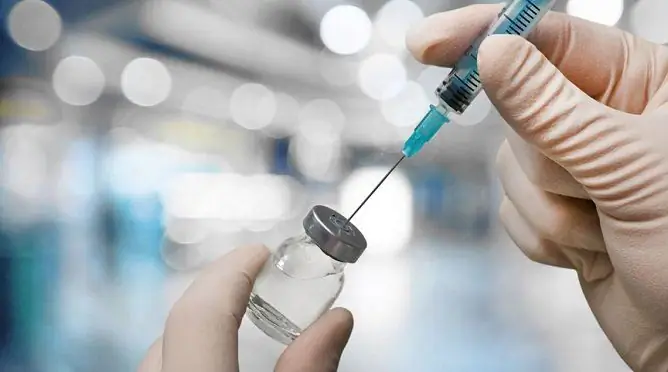- Author Rachel Wainwright [email protected].
- Public 2023-12-15 07:39.
- Last modified 2025-11-02 20:14.
Cervarix
Cervarix: instructions for use and reviews
- 1. Release form and composition
- 2. Pharmacological properties
- 3. Indications for use
- 4. Contraindications
- 5. Method of application and dosage
- 6. Side effects
- 7. Overdose
- 8. Special instructions
- 9. Application during pregnancy and lactation
- 10. Use in childhood
- 11. Drug interactions
- 12. Analogs
- 13. Terms and conditions of storage
- 14. Terms of dispensing from pharmacies
- 15. Reviews
- 16. Price in pharmacies
Latin name: Cervarix
ATX code: J07BM02
Active ingredient: L1 proteins of human papillomavirus type 16 and 18
Producer: GlaxoSmithKline Biologicals (Belgium)
Description and photo updated: 20.11.2018

Cervarix is a bivalent recombinant vaccine for the prevention of diseases caused by the human papillomavirus (HPV).
Release form and composition
Cervarix vaccine is produced in the form of a suspension for intramuscular (i / m) administration: white, homogeneous, with an opaque structure, without foreign inclusions, after settling 2 layers are formed: the lower one is in the form of a white precipitate, the upper one is a colorless transparent liquid [0.5 each ml in vials / syringes: 1 or 10 vials in polyethylene blisters, 1 blister in a cardboard box; 5 bottles in polyethylene blisters, in a cardboard box 2 blisters; in a cardboard box 100 bottles; 1 or 10 syringes in polyethylene blisters, complete with 1 or 2 needles (or without them), in a cardboard box 1 blister; 5 syringes complete with 1 or 2 needles (or without them) in a polyethylene blister, in a cardboard box 2 blisters; in cardboard boxes of 10 syringes, complete with 1 or 2 needles (or without them)].
0.5 ml (1 dose) of the suspension contains:
- active substance: L1 proteins of human papillomavirus types 16 and 18 - 0.02 mg of each type;
- auxiliary components: aluminum hydroxide, lipid A 3-o-deacyl-4-monophosphoryl, sodium dihydrogen phosphate dihydrate, sodium chloride, water for injection.
Pharmacological properties
Cervarix is a recombinant adsorbed vaccine for the prevention of diseases caused by HPV, which consists of a mixture of virus-like particles of recombinant surface proteins of HPV types 16 and 18. The vaccine contains the adjuvant AS04, which enhances its effect.
To obtain L1 proteins of HPV types 16 and 18, recombinant baculoviruses HPV-16 and HPV-18 are used in the culture of Trichoplusia ni cells (Hi-5 Rix4446). The adjuvant AS04 contains 3-O-deacyl-4'-monophosphoryl lipid A (MPL) and aluminum hydroxide.
Oncogenic human papillomaviruses, according to epidemiological data, are the cause of the majority of cases of cervical cancer, of which more than 70% arose due to HPV-16 and HPV-18. The development of cervical intraepithelial lesions in about 50% of women is associated with these types of the virus.
The clinical efficacy of the vaccine against HPV-16 and HPV-18, and the consequences of infection, is confirmed by the results of studies and observations of patients vaccinated at the age of 15-25 over the next 4 years. They indicate that the effectiveness of Cervarix in vaccination to prevent infection is 94.7%, in relation to cervical infection persisting for at least 6 months - 96%, in relation to cervical infection persisting for at least 12 months - 100%, in relation to HPV infection detected at the stage of cytological disorders - 95.7%.
As a result of vaccination, 100% of patients developed protection against histologically detectable HPV infection at the stage of intraepithelial cervical neoplasia 1 and 2 degrees (CIN1 and CIN2) and higher. Regardless of the type of DNA (deoxyribonucleic acid) of the HPV virus, the vaccine in 73.3% of individuals is effective against the development of any CIN2 lesions.
Cervarix provides cross-protection against any manifestations of HPV infection, established cytologically, caused by other oncogenic HPV types in 40.6% of vaccinated patients.
The scheme of the full course of immunization consists of three doses of the vaccine. The immunogenicity of the vaccine contributes to the formation of specific antibodies against HPV-16 and HPV-18, which are determined 18 months after the last dose in 100% of vaccinated people aged 10 to 25 years.
After completing the course of vaccination, the greatest severity of the immune response is noted immediately, antibodies persist for 4 years from the moment the first dose was administered.
The antibodies produced have a neutralizing ability. Upon completion of the vaccination course, all initially seronegative women (including those aged 46-55 years) became seropositive. The value of the protective level of antibodies remains unchanged for four years. The AS04 adjuvant system contributes to an increase in the duration of the immune response.
Indications for use
According to the instructions, Cervarix is indicated only to females for the prevention of the following pathologies of high oncogenic risk:
- cervical cancer between the ages of 10 and 25;
- acute and chronic HPV infections;
- cellular disorders including the development of atypical flat cells of unclear significance (ASC-US);
- intraepithelial cervical neoplasia (CIN);
- precancerous lesions (CIN2 +) caused by oncogenic HPV in women aged 10 to 25 years.
Contraindications
- period of pregnancy;
- breast-feeding;
- age up to 10 years;
- a period of an acute febrile state, including against the background of an exacerbation of a chronic disease (until the complete absence of signs of fever);
- hypersensitivity reactions to the previous administration of Cervarix;
- individual intolerance to the components of the vaccine.
Care should be taken when vaccinating women with disorders of the blood coagulation system, thrombocytopenia.
Instructions for the use of Cervarix: method and dosage
The suspension is injected intramuscularly, in the deltoid muscle region.
You can not enter Cervarix intravenously or intradermally.
Before use, the suspension must be visually inspected to ensure that there are no foreign particles in it. If, when examining the vaccine, the presence of foreign particles is found, or does not correspond to the description below, then the vial or syringe with the contents should be disposed of.
Cervarix can be administered if, after vigorous shaking, an opaque, whitish suspension forms in a syringe or vial.
A single dose for all patients over 10 years of age is 0.5 ml.
For primary immunization, the 0-1-6 scheme is used, according to which after the first dose of Cervarix is administered, the second dose is administered with an interval of 1 month, and 6 months after the second dose, the third.
Revaccination is not performed.
Side effects
- infectious complications: sometimes - upper respiratory tract infections;
- from the digestive system: often - abdominal pain, diarrhea, nausea, vomiting;
- from the central nervous system: very often - headache; sometimes dizziness;
- on the part of the musculoskeletal system and connective tissue: very often - myalgia; often - arthralgia; rarely - muscle weakness;
- dermatological reactions: often - skin itching, urticaria, rash;
- on the part of the body as a whole: very often - a feeling of fatigue; often - an increase in body temperature above 38 ° C;
- reactions at the injection site: very often - a feeling of pain, redness, swelling; sometimes - itching, induration at the injection site, decreased local sensitivity.
Overdose
Overdose symptoms have not been established.
special instructions
The risk of bleeding should be taken into account with the intramuscular administration of Cervarix to patients with thrombocytopenia or disorders of the blood coagulation system.
Vaccination should be carried out in a treatment room provided with anti-shock therapy. After the injection, the patient must be under medical supervision for 0.5 hour, this is associated with the risk of developing an anaphylactic reaction.
It has not been established that the vaccine is capable of causing the processes of regression of lesions or preventing the progression of existing pathologies caused by HPV-16 and / or HPV-18.
The results of clinical studies confirm the safety and immunogenicity of the drug when used in individuals who are seropositive for HPV types 16 and / or 18, in whom cytological examination did not find signs of intraepithelial lesion or found only atypical flat cells of unknown significance (ASC-US).
The use of Cervarix does not protect against infection and diseases caused by some types of HPV.
Vaccination, as a method of primary prevention of HPV, implies the need for secondary prevention of the disease in the form of regular medical examinations.
In immunodeficiency states, including human immunodeficiency virus (HIV) infection, there may be a lack of an adequate immune response.
Influence on the ability to drive vehicles and complex mechanisms
It is recommended to exercise caution for some time after vaccination while driving or working with complex mechanisms, since undesirable phenomena may develop that reduce the rate of psychomotor reactions.
Application during pregnancy and lactation
Since the safety and efficacy of using Cervarix during gestation has not been established, it is recommended that vaccination be carried out only after childbirth.
If it is necessary to use the vaccine during lactation, breastfeeding should be discontinued.
Pediatric use
Immunization with Cervarix of girls under the age of 10 is contraindicated.
Drug interactions
There is no information on the interaction of Cervarix with simultaneous use with other vaccines.
The negative effect of oral contraceptives on the effectiveness of the Cervarix vaccine has not been established.
It is assumed that an adequate immune response may not be achieved when the vaccine is combined with immunosuppressants.
Analogs
The analogue of Cervarix is Gardasil.
Terms and conditions of storage
Store at temperatures up to 2-8 ° C, keep away from freezing. Keep out of the reach of children.
The shelf life is 3 years.
Terms of dispensing from pharmacies
Dispensed by prescription.
Reviews about Cervarix
Reviews of Cervarix are quite contradictory and often unfounded. Mostly they write patients who have not been vaccinated and do not advise others. They argue their choice with insufficient depth and breadth of coverage of the clinical trials, lack of information about the need for revaccination, and the effect of the vaccine on a woman's reproductive function.
Women who have been vaccinated give a positive assessment of the drug. They note the positive dynamics of the results of laboratory tests, good tolerance of Cervarix.
Price for Cervarix in pharmacies
The price of Cervarix for one dose can range from 1500 to 1800 rubles.

Maria Kulkes Medical journalist About the author
Education: First Moscow State Medical University named after I. M. Sechenov, specialty "General Medicine".
Information about the drug is generalized, provided for informational purposes only and does not replace the official instructions. Self-medication is hazardous to health!






